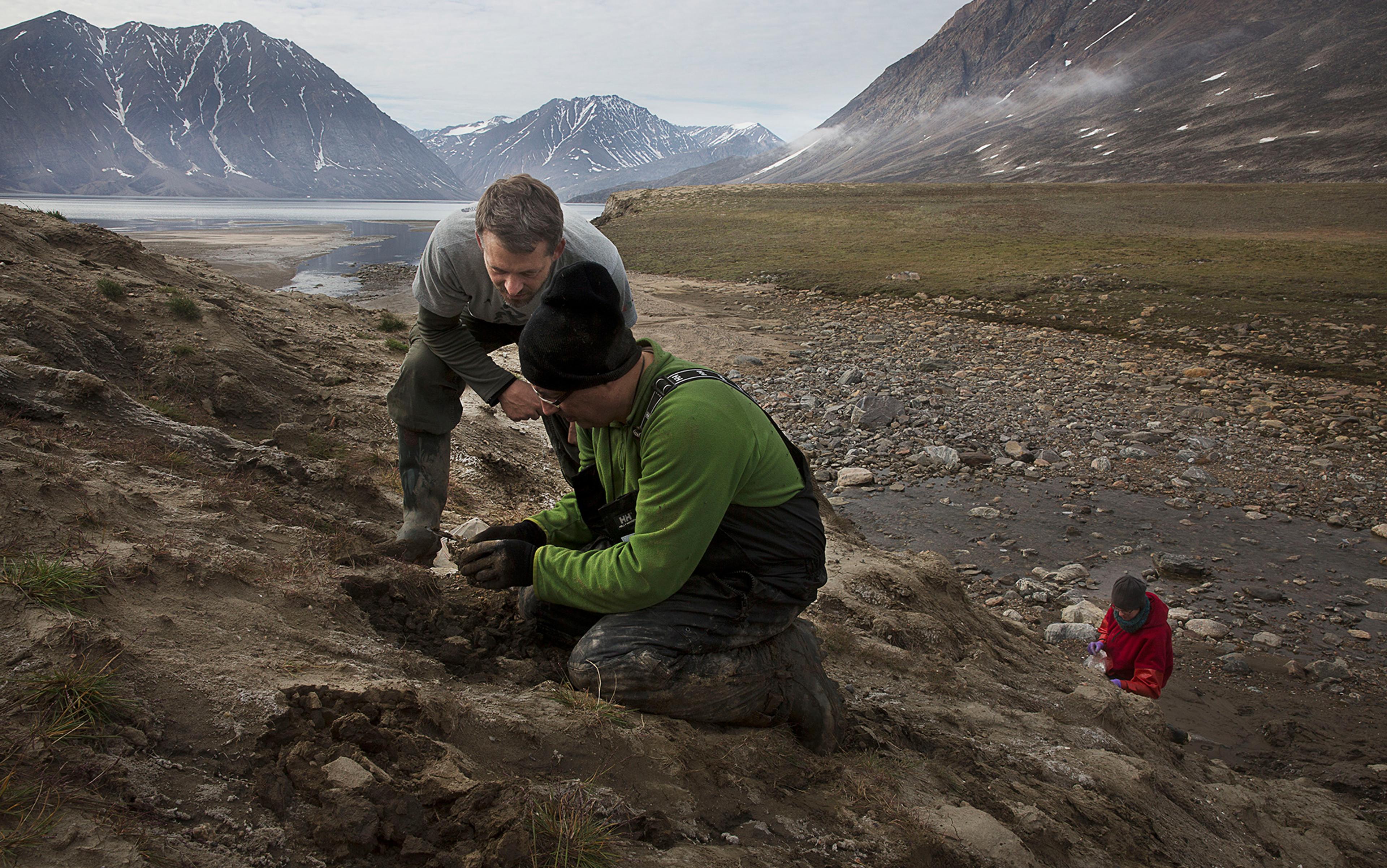When a scientific paradigm breaks down, scientists need to make a leap into the unknown. These are moments of revolution, as identified by Thomas Kuhn in the 1960s, when the scientists’ worldview becomes untenable and the agreed-upon and accepted truths of a particular discipline are radically called into question. Beloved theories are revealed to have been built upon sand. Explanations that held up for hundreds of years are now dismissed. A particular and productive way of looking at the world turns out to be erroneous in its essentials. The great scientific revolutions – such as those instigated by Copernicus, Galileo, Newton, Lavoisier, Einstein and Wegener – are times of great uncertainty, when cool, disinterested reason alone doesn’t help scientists move forward because so many of their usual assumptions about how their scientific discipline is done turn out to be flawed. So they need to make a leap, not knowing where they will land. But how?
To explain how scientists are able to make this leap, the philosopher of science Bas van Fraassen in The Empirical Stance (2002) drew on Jean-Paul Sartre’s Sketch for a Theory of the Emotions (1939). Sartre was dissatisfied with the major mid-20th-century theories about emotions (especially those by William James and Sigmund Freud) that treated emotions as mere passive states. You might fall in love, or be gripped with jealousy. It seemed that emotions happened to you without any agency on your part. Sartre, by contrast, held that emotions are things that we do. They have a purpose, and they are intentional. For example, when we get angry, we do so to seek a solution, to resolve a tense situation. Sartre wrote:
When the paths before us become too difficult, or when we cannot see our way, we can no longer put up with such an exacting and difficult world. All ways are barred and nevertheless we must act. So then we try to change the world.
The world that Sartre referred to is the world of our subjective experience. It is the world of our needs, our wants, our fears and our hopes. In his view, emotions transform the world like magic. A magical act, such as voodoo, alters the attitude of the practitioner to the world. Magical spells and incantations don’t change the physical environment, but they change our world, by shifting our desires and hopes. Similarly, emotions change our outlook and how we engage with the world. Take Sartre’s example of sour grapes: seeing that the grapes are unreachable, you decide, ‘they are too sour anyway’. Though you didn’t change the chemical property of the grapes in any way, the world has become a bit more bearable. Anticipating contemporary ideas about embodied cognition, Sartre speculated that physical actions help us to produce emotions. We clench our fists in anger. We weep in sadness.
Applying this idea to scientific practice, Van Fraassen argues that scientists draw on their emotions when dealing with new, bewildering ideas, especially those that sprout up during scientific revolutions. If the paradigm is faltering, scientists need to change the way they view the world – and this requires that they change themselves. Scientists need to transform both who they are and what they know. Only once scientists themselves are transformed in this way can they accept a theory that they originally thought outlandish or ridiculous.
There are a few problems with this theory. Van Fraassen doesn’t specify which emotions can help scientists. Would it be sufficient to be intrigued or excited by a new theory, or to feel curiosity? Would anger at the failure of the old paradigm do the job? And it’s not clear how scientists can use emotions to change their minds. Sartre seems at times to assume that we have our emotions under direct voluntary control. But this appears implausible, on the face of it. Surely not all our emotions are under our direct control?
One way to salvage the Sartre and Van Fraassen account is to propose that emotions are under our indirect control. We can’t control our emotions directly, but we can engage in practices that, over time, help to shape how we emotionally respond to a variety of situations. And as for which emotion most helps scientists, I have a particular one in mind: awe.
In their classic account of awe, the psychologists Dacher Keltner and Jonathan Haidt characterise awe as a spiritual, moral and aesthetic emotion. In their view, all clear cases of awe have the following two components: an experience of vastness, and a need for cognitive accommodation of this vastness. You might feel awe for things that are physically large, but also for ideas that are conceptually vast. For example, at the end of the first edition of his Origin of Species (1859), Charles Darwin expressed awe for his theory of natural selection:
There is grandeur in this view of life, with its several powers, having been originally breathed into a few forms or into one; and that, whilst this planet has gone cycling on according to the fixed law of gravity, from so simple a beginning endless forms most beautiful and most wonderful have been, and are being, evolved.
The need for cognitive accommodation makes you aware that there is a lot you don’t know. You feel small, insignificant and part of something bigger. In this way, awe is a self-transcendent emotion because it focuses our attention away from ourselves and toward our environment. It is also an epistemic emotion, because it makes us aware of gaps in our knowledge. We can feel overwhelmed looking at the night sky, deeply aware that there is so much we don’t know about the Universe. In one recent study, participants listed nature as their most common elicitor of awe, followed by scientific theories, works of art and the achievements of human cooperation.
The philosopher Adam Morton speculates that epistemic emotions play a crucial role in scientific practice. Imagine a scientist who knows the latest research techniques, and who is intelligent and analytical. If she lacks curiosity, awe and other epistemic emotions, she won’t have the drive to become a good scientist, who can change her mind on the basis of evidence, explore new hypotheses or pay attention to unexpected results. As Van Fraassen argued, to change the field or accept radical changes in it, you need to alter your outlook on the world. Awe can do this. It focuses attention away from yourself and makes you think outside of your usual thought patterns.
‘Those who dwell … among the beauties and mysteries of the Earth are never alone or weary of life’
Many scientists have noted in their autobiographical writings how their sense of awe drove their scientific work. Here is the evolutionary biologist Richard Dawkins in Unweaving the Rainbow (1998):
The feeling of awed wonder that science can give us is one of the highest experiences of which the human psyche is capable. It is a deep aesthetic passion to rank with the finest that music and poetry can deliver. It is truly one of the things that make life worth living, and it does so, if anything, more effectively if it convinces us that the time we have for living it is finite.
The conservationist Rachel Carson identified awe as a source of resilience in difficult times. In an echo of Sartre’s theory of emotions as a source of refuge, in 1956 she insisted that we should encourage children to maintain and develop their sense of awe so that it doesn’t diminish over time:
What is the value of preserving and strengthening this sense of awe and wonder, this recognition of something beyond the boundaries of human existence? Is the exploration of the natural world just a pleasant way to pass the golden hours of childhood or is there something deeper? I am sure there is something much deeper, something lasting and significant. Those who dwell, as scientists or laymen, among the beauties and mysteries of the Earth are never alone or weary of life. Whatever the vexations or concerns of their personal lives, their thoughts can find paths that lead to inner contentment and to renewed excitement in living.
Empirical evidence suggests that awe plays a role in the appreciation of science. These studies provide a tentative glimpse of how awe and science relate, even though they focus on laypeople, and not (yet) on scientists themselves. Writing in 2018, the psychologists Keltner, Sara Gottlieb and Tania Lombrozo found that the tendency to feel awe (dispositional awe) is positively associated with scientific thinking in non-scientists. Participants with higher dispositional awe have a comparably better grasp on the nature of science, are more likely to reject Young Earth creationism, and also are more likely to reject unwarranted teleological explanations for natural phenomena. When awe is induced, people feel more positive toward science. One recent study showed participants a movie montage of the BBC TV series Planet Earth, containing sweeping vistas of waterfalls, canyons, forests and other awe-inducing views. Participants in a control condition watched humorous videos of cute animals engaged in capers and antics. Those who saw the awe-inspiring videos were more aware of gaps in their knowledge than those who saw the funny videos.
This suggests that eliciting awe would be good for scientific practice. How can we do that? The theologian and philosopher Abraham Joshua Heschel argued for the importance of awe in two short books, Man Is Not Alone (1951), and God in Search of Man (1955). Heschel thought that people are taking the world for granted, thereby losing their ability to experience it with depth and reverence. We have taken to a kind of complacency where we think that science can solve all our problems, without pausing to think about the marvels that science has revealed to us. ‘Modern man fell into the trap of believing that everything can be explained, that reality is a simple affair which has only to be organised in order to be mastered,’ he wrote. According to Heschel, awe and wonder are the antidotes.
Like Sartre, Heschel held that emotions are a kind of cognitive technology, things we do purposively to change the world. But Heschel (unlike Sartre) didn’t think that the main transformative effect of emotions was to make an unbearable and conflicted world bearable. Rather, Heschel thought that emotions could help us to see the world not in flat, drab and purely instrumental terms, but as valuable for its own sake, filled with marvels. Deep knowledge, of the kind attained by profound scientific insight or, for Heschel, religious wisdom, requires that we see the world in these terms: as an end, beautiful in itself. And for that, awe is required.
How is awe evoked? Heschel argued that Jewish rituals are conducive to awe: there are blessings that orthodox Jews utter at particular occasions, for example, when you see a rainbow, or notice the first tenuous blossoms on fruit trees, or meet a wise person, or hear good news. These blessings are embodied physical actions that one performs to mark certain emotional states in response to the environment. The repetition of ritual practices trains our minds and bodies to respond with awe and wonder to the world around us. By uttering a blessing, you become more attuned to how precious and fleeting these things are. For Heschel, rituals are not a form of adjusting yourself to the world. They are the opposite: they are about maladjustment: ‘Wonder or radical amazement, the state of maladjustment to words and notions, is therefore a prerequisite for an authentic awareness of that which is.’ Conceived this way, Jewish rituals are an antidote to falling into ruts. They drive us out of our dull complacency, and help us to see the world in a new light.
While it is easy to see how rituals can help us instil awe in religion, it’s not so clear how rituals would achieve the same thing in scientific practice. Heschel was skeptical that scientists could use ritual practices to induce awe: ‘A scientific theory, once it is announced and accepted, does not need to be repeated twice a day.’ This dismissal is too hasty. The rise of denialism about science indicates that a scientific theory isn’t announced and accepted once and for all. Even a long-discredited theory such as flat Earth can resurge in the wake of misinformation campaigns.
There are already ritualistic elements in scientific practice that might help to instil awe. For example, scientists who replicate an experiment often faithfully stick to the minutiae of experimental design. Indeed, according to the philosopher Nicholas Shea:
There may be no good reason for using 10 ml rather than 20 or 5 ml of some solvent, say. This may just be the way it was first done, and since it worked no one has bothered to find out if the quantity could be varied. Indeed, some experiments are so tricky to get right that practitioners show an almost religious adherence to the letter of a known protocol.
Awe thus plays an important role in the day-to-day work of scientists, which Kuhn called ‘normal science’, when it is business as usual and scientists are tweaking, rather than changing, their views. But, as I suggested at the outset, awe is especially important in revolutionary science, when scientists are grappling for new ideas and new concepts. Here, ritualistic practices might be only of limited help, but a radical reorientation is needed.
Next to ritual, there is a second way in which we can cultivate awe. We can experience it vicariously, by reading the writings of others. As the philosopher Edmund Burke, who in 1757 wrote a seminal work on the sublime, remarked:
[T]here are many things of a very affecting nature, which can seldom occur in the reality, but the words that represent them often do, and thus they have an opportunity of making a deep impression and of taking root in the mind, whilst the idea of the reality was transient …
This is relevant for science, because scientific theories often encompass things we cannot directly experience, so-called scientific unobservables: electrons, the early universe, dinosaurs and Neanderthals are examples. How can scientists come around to accepting such unobservables, if proof for them can never be definite?
Awe increases our tolerance for uncertainty and opens our receptivity to new and unusual ideas
The psychologist Benjamin Sylvester Bradley has argued that Darwin’s Origin of Species was successful in establishing a new paradigm in part because it relied on a Romantic or Kantian notion of the sublime. While Darwin’s book was not the first to use evolutionary theory to explain how new species came into existence, his work was an unusual combination of scientific rigour and poetic reflection on nature’s vastness and complexity. In it, Darwin also frequently mentions our lack of knowledge, our difficulty imagining the vast timespans under which evolution happens, which are all elicitors of awe. For example:
Professor Ramsay has published an account of a downthrow in Anglesea of 2,300 feet; and he informs me that he fully believes there is one in Merionethshire of 12,000 feet; yet in these cases there is nothing on the surface to show such prodigious movements; the pile of rocks on the one or other side having been smoothly swept away. The consideration of these facts impresses my mind almost in the same manner as does the vain endeavour to grapple with the idea of eternity.
Awe increases our tolerance for uncertainty and opens our receptivity to new and unusual ideas, which are crucial for paradigm change. Mary Somerville’s On the Connexion of the Physical Sciences (1834) was a highly popular synthesis of science of this time, and also anticipated novel ideas such as the existence of Neptune due to orbital anomalies long before it was discovered by telescope, and the existence of exoplanets and other not yet detected astronomical matter. Frequently, Somerville appealed to the readers’ sense of awe, as here:
So numerous are the objects which meet our view in the heavens, that we cannot imagine a part of space where some light would not strike the eye; innumerable stars, thousands of double and multiple systems, clusters in one blaze with their tens of thousands of stars, and the nebulæ amazing us by the strangeness of their forms and the incomprehensibility of their nature, till at last, from the limit of our senses, even these thin and airy phantoms vanish in the distance. If such remote bodies shone by reflected light, we should be unconscious of their existence. Each star must then be a sun, and may be presumed to have its system of planets, satellites, and comets, like our own; and, for aught we know, myriads of bodies may be wandering in space unseen by us, of whose nature we can form no idea, and still less of the part they perform in the economy of the universe.
This blending of the poetic and the scientific is what Kathryn Neeley in her biography of Somerville called the scientific sublime, ‘the capacity of the vision of nature revealed through science to summon forth the same sense of majesty and power that human beings feel in the presence of God.’
Awe is required not only for the day-to-day working of science, but is also crucial to help reorient scientists’ thinking in times of paradigm change. It provides constant emotional motivation for scientists to continue their work, and it instils openness to scientific ideas in the public. While precision and rigour are important, the emotional drive of awe is what matters – it might be, as Heschel speculated, our only path to knowledge and wisdom.






